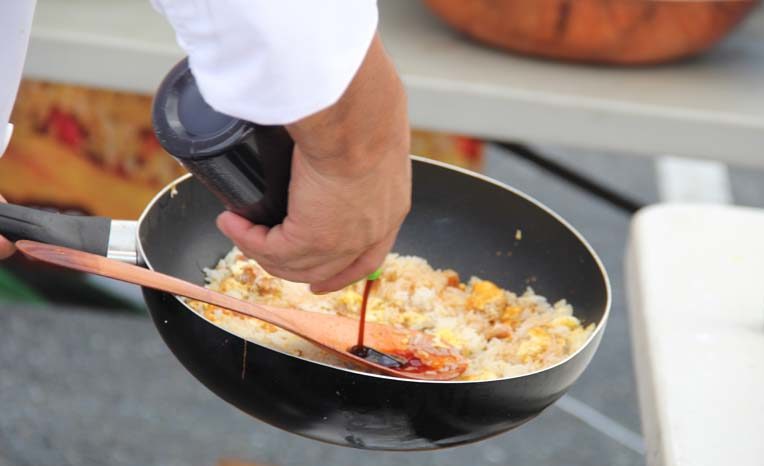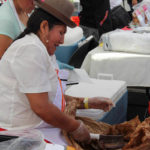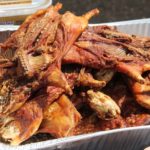
Peruvian food is a study in juxtaposition. Robust, coal-fired meat and potato offerings stand alongside more delicate dishes dealing in cold temperatures and acidic flavors.
This wide range of culinary contributions is a product of the Peruvian landscape, which features a globe’s worth of climates and a range of altitudes, producing an impressively diverse scope of flora, fauna and everything in between. The humble potato boasts close to 4,000 varieties in Peru, along with a deep wealth of corn, grains and native chilies.
The country’s national dish is ceviche, a dish made with raw seafood and fish that is cured in citrus juices like lemon or lime, and spiced with chili peppers. Though many countries claim to have invented the dish, most agree that this cold delicacy originated in Peru with five simple ingredients: sea bass, lime juice, onion, salt and hot chilies.
Stateside, Peru’s most well-known food is easily pollo la brasa, or roasted chicken. This poultry preparation involves marinating a whole bird in a potent and addictive mix of garlic, herbs and spices before roasting it on a spit. As it rotates amid a kiss of flames, the skin slowly transforms into a golden crisp with spice and fire combining to produce exotic aromas and earthy flavors.
From the more exotic end of the Peruvian table is cuy, or guinea pig. Involving this small mammal in any meal preparation might seem barbaric to those north of the border, and the sight of a roasted guinea pig’s head frozen in an eternal scream might be unnerving for some, but it is one of the most popular sources of protein in Peru’s Andean region. Think of it as suckling pig for one—unctuous, smoky and dark meat with a cap of crackling, flavorful skin. It sounds anything but scary.
The striking dish was merely one of the features at the recent Sumaq Peruvian Food Festival, held at the Cradle of Aviation in Garden City in August. Sumaq translates to “delicious” in the indigenous language of Quechua. and the annual event brings Peruvian food proprietors from across the country, as well as establishments directly from the South American homeland. The festival features the gentle blend of ancient Incan cooking practices and immigrant traditions from Spain, Africa and Japan, is what makes Peruvian cuisine unique and is steadily conquering the interest of everyone around the world. Sumaq’s mission, according to organizers, is to help expand Peruvian cuisine and culture in New York.
One of the restaurants at the festival, La Matarina Restaurante Turístico from Lima, Peru, is known affectionately as La Catedral del Cuy, or The Cathedral of the Guinea Pig. At the food festival, the restaurant served its guinea pig two ways—in a spicy tomato-based sauce and straight-up fried. While both were tasty, the fried version offered crispy skin, which put it over the top. As for what guinea pig tastes like, think rabbit with a pork exterior.

While the Sumaq festival is the perfect opportunity to sample all of the gastronomic delights of Peru, it is sadly only held once a year. Luckily, there are plenty of Peruvian restaurants scattered around Long Island, so there is no need to wait until next summer.
Brasas Peru in Franklin Square (673 Franklin Ave.), is a small restaurant that is big on flavor and customer service. Since it opened last year, this independent and family-owned restaurant offers an array of homemade recipes to satisfy local Peruvian gastronomy.
At Brasas, the pollo a la brasa is a must and fulfills the promise of Peru—dynamically flavored whole-roasted chicken that decimates poultry from any establishment, fast food or otherwise. The chicken is the centerpiece of Brasas’ generously priced combos. Go for combo no. 2, which includes a whole chicken, avocado salad, yellow rice, beans, tostones (fried plantains) and salchipapa (basically hot dogs and French fries, but even better than it sounds).
Other keenly prepared dishes at Brasas include arroz chaufa, which is Peruvian style Chinese fried rice; bistec a lo pobre, a dish with marinated steak served with a fried egg, French fries, sweet plantains and white rice; and of course, ceviche de pescado, which features fish cured in lime juice.
On the weekends, Brasas expands its menu to offer specialty dishes for customers who want to expand their Peruvian palate. These dishes include a fried seafood extravaganza called jalea, and choros a la chalaca, which is a Peruvian take on mussels.
Peruvian food is romantic and curiously unique. It is striking in both preparation and flavor and is a take on Hispanic cuisine worth exploring.


























